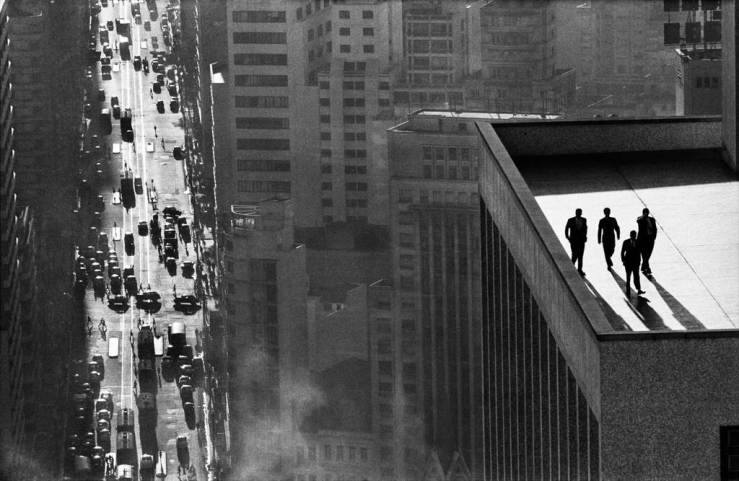I have decided to start a new photography series: “Learn from the Masters”. I would like to introduce you to some of the most iconic photographers, who have shaped modern photojournalism, street photography and photo documentary. I believe that nothing will help you to improve as photographers as learning from the masters of this art and taking them as a reference point.
Every article will describe the life and achievements of each photographer and will be concluded by the lessons that we can learn from each master.
Career
Rene Burri was born in Zürich, Switzerland in 1933. His passion for arts and filmmaking led him to enrol into the School of Applied Arts in his native city.
Interestingly, even though this great artist is well-known for his photographic work, Burri started his career as a video maker. He worked as a documentary film maker first and as a cameraman for Disney then.
This passion for filming allowed him to travel around the world and getting more confident with the still image format. In his early life, Burri travelled extensively around the world, visiting countries such as: Spain, Italy, Korea and Japan. Such journeys led to several publications around the world and attracted Magnum attention as well. Indeed, Burri became an associate of the famous photography agency in 1955 and became full member 4 years later, in 1959.
Probably, this great photographer is mostly known for his photographs of ‘Che’ Guevara, Picasso, Le Corbusier and his extensive coverage of post-war Germany.
Before dying at the age of 81 in Zürich, Burri was awarded the Honorary Fellowship of the Royal Photographic Society and the Dr. Eric Salomon Prize among others.
Lessons Learnt:
1. Black and White and Colour Photography Coexist

René Burri, 1969, Magnum Photos
Burri was born in a period in which photographers did not have the luck of being able to choose between black and white and colour photography easily. Indeed, colour photography entered the mainstream between the 70’s and the 80’s only.
As soon as colour photography became more popular, Burri decided to experiment with this new type of visual tool. He declared that he had been living “a life as a photographer – one in black and white and one in colour.”
Indeed, most of his works were shot in monochrome. However, he produced an incredible photo-book, called: “Impossible Reminiscences”, which is in colours completely. Actually, he decided to group photographs depending on the predominant colour, starting from purple up to red. He wanted future viewers to be drawn into this evolving rainbow, the same rainbow of colours he decided to use to photograph the human nature.
René Burri offers us a great lessons through this attitude to photography. Indeed, we should avoid to tag ourselves as colour or black and white photographers. On the other hand, we should approach the medium with a wider perspective and decide whether to convert to monochrome or not depending on the specific aim and characteristics of each photograph.
2. Photograph to Discover Yourself

René Burri, 1957, Magnum Photos
Burri stressed during several interviews this point. Indeed, he not only photographed to capture the ‘decisive moment’ or the real nature and condition of what was before the lens. He also photographed to dig into his soul and know more about himself.
This is very interesting because even though he was a renowned photographer, who received several important assignments, he felt the urgency to detach from this type of activities from time to time. Indeed, he used to take some time off for himself and his personal interests. Ultimately, he was using this time to photograph what he was most passionate about.
This approach to photography allowed him to establish strong personal relationships with several of his subjects, which enriched his fame and his life in a broader sense.
We should never forget that we first approached photography for a reason. Certainly, we were first passionate about something, which could be a subject, a genre or even a place. Well, mantainig a connection with this passion allows us to stay true to ourselves and keep being creative even when our lives and jobs lead us on a different path.
3. The Impossibility of Catching Everything

René Burri, 1974, Magnum Photos
Burri used to stress often that photographers are only humans. This means that photographers have their fragility, weaknesses and limits. Indeed, it is impossible for a single person to capture everything, every single meaningful action, that is occurring thoughout the world.
Nevertheless, he hoped to be remembered as a person, who was able to see most of what should have been seen and managed to capture enough through his camera.
In order to achieve this desire, Burri highlighted the importance of being fast and receptive. He joked saying that he developed these skills catching flies in his grandparents’ farms during the war.
Moreover, Burri used to argue how lucky photographers are. Indeed, we can decide what to capture and what to include within the frame in order to share a specific message and feeling. However, we should never forget that as photojournalists and street photographers, our aim should be the one of capturing the reality of facts, the truth.
We should always remember that our work is judged on the quality of what we have done, not on the ‘possible quality’ of what we have missed. Therefore, we should always commit ourselves fully to what we are doing in order to represent it in the most meaningful and appealing way possible.
4. Hard Work Leads to Fame

René Burri, 1960 , Magnum Photos
One of the most iconic photographs of this master was made in Rio de Janeiro. Many of you would have seen it somewhere: movies, magazines or even books.
Burri made this photograph on assignment for a famous german magazine to document the raise and contrasts of Brazil. He told some interviewees how he was trying to capture Rio from above, when some men appeared from nowhere on the top of the underlying roof. He captured the 5 men quickly and responsively, who vanished a few seconds later. The same situation never manifested – and will never show up – again.
Even though Burri did not publicise that particular photograph, that image became the representation of the raising capitalism in Brazil. Burri himself argued that fame snowballed for that specific shot to a proportion that was out of his imagination.
That is often a good representaion of reality: sometimes fame snowballs. It starts as a simple photograph and becomes a symbol to represent one of the strongest raising economies of the world. However, we should ask ourselves: would have Burri made that photograph from home? Would have he made that image without climbing up the highest rooftop of that building? The obvious answer is NO!
It is impossible to achieve fame without working hard. It is impossible to achieve fame without overcoming an unimaginable number of hurdles and not giving up.
Conclusion
René Burri is one of the most influential artists in photojournalism and photo documentary. His photographs lead us into the life of unforgettable characters and devastating realities.
From his life, sprinkled with successes, we can extract some important learning outcomes to improve as photographers.
Firstly, we should avoid to tag ourselves as monochrome or colour photographers. We should be open to both expressions and choose accordingly to the single image characteristics.
Secondly, we should never lose touch with our passions and our interests. Only by staying true to ourselves we can ensyure a prolific and lasting career.
Thirdly, we will never be able to capture everything going on around the world. We should aim to photograph enough of it, by maintaining high standards and always representing the truth.
Lastly, we should stop seeking fame spasmodically. Indeed, fame snowballs and more often than not it is triggered by others rather than by ourselves. However, we should always work hard and consistently to be ready to embrace fame as the opportunity comes.
Related Articles
‘Learn from the Masters’ Series:
- Learn from the Masters: Bruce Davidson
- Learn from the Masters: Bruce Gilden
- Learn from the Masters: Elliott Erwitt
- Learn from the Masters: Ferdinando Scianna
Photography Tips:
- Black and White or Colour Photography?
- How to Find Your Unique Style
- 3 Tips to Be More Productive When Making Street Photographs
- Why Equipment Matters
Photography Basics:


Wonderful new series. This post on Rene Burri is informative and inspiring!
LikeLiked by 1 person
It was really inspiring to write as well. I think that is a fret opportunity of mutual learning: for my audience and myself
LikeLiked by 1 person
Wow! Very interesting and eye opening!
LikeLiked by 1 person
I hope that I will be able to post another great master’s story today. I feel this series can be really inspiring for all of us
LikeLiked by 1 person
[…] Learn from the Masters: René Burri […]
LikeLike
[…] Learn from the Masters: René Burri […]
LikeLike
One of my favorites. His brave use of color is stunning.
LikeLiked by 1 person
I couldn’t agree more. He is quite genial indeed. Hope that you will like my latest articles on Davidson and Gilden as well and will stay tuned for more posts in the future
LikeLike
Reblogged this on Photography//Travel and commented:
Im teaming up with Pier over at phppistreetphoto.com to bring you this post. Rene Burri was one of the first photographers I was inspired by when I first started studying photography. Pier has written this great post all about learning from Burri’s talents.
LikeLiked by 1 person
Thank you so much for this reblog. I am really glad to have found the change to collaborate with you.
LikeLike
I especially like your saying that we should not lose touch with our passions and interests and that we need to stay true to ourselves. I have noticed that while I take several kinds of photographs, the ones that please me the most are the ones that connect most to my main passions.
LikeLiked by 1 person
This is exactly what I feel too
LikeLike
[…] Learn from the Masters: René Burri […]
LikeLike
[…] Learn from the Masters: René Burri […]
LikeLike
[…] Learn from the Masters: René Burri […]
LikeLike
[…] Learn from the Masters: René Burri […]
LikeLike
[…] Learn from the Masters: René Burri […]
LikeLike
[…] Learn from the Masters: René Burri […]
LikeLike
Lovely article
LikeLiked by 1 person
Thank you
LikeLike
[…] Learn from the Masters: René Burri […]
LikeLike